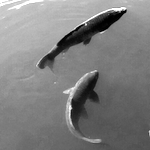Fish achieve highly efficient and agile swimming by leveraging elastic fins. Fish fins can have a variety of shapes and they are typically tapered in thickness from the base to the trailing edge. The hydrodynamic benefits of fin thickness tapering remain practically unexplored. We use fully coupled fluid structure interaction computational modelling to probe the hydrodynamic performance of biomimetic elastic fins with tapered thickness. We consider rectangular elastic fins with different tapering geometries that periodically oscillate in a viscous fluid. The simulations reveal that thickness tapering drastically increases the hydrodynamic thrust and efficiency of oscillating elastic fins that greatly exceed the performance of fins with uniform thickness. Furthermore, tapered fins can maintain high performance for a wide range of actuation frequencies. We relate the hydrodynamic benefit of thickness tapering to the development of traveling flexural waves propagating along the fin. Thickness tapering slows the wave speed, thereby reducing flexural wave reflection at the fin training edge, a phenomenon referred to as an acoustic black hole, that promotes the development of traveling waves propagating along the fin. We characterize the amount of traveling and standing waves in the bending patterns of fins with different thickness profiles and show that indeed fins with the greater amount of traveling waves yield the best hydrodynamic performance. By analyzing the differences in flow patterns generated by fins with the traveling and standing wave oscillations we demonstrate that traveling waves promote transport of side edge vortexes towards the fin trailing edge enhancing trailing edge vorticity that contributes to the efficient fin propulsion. The results of the simulations not only provide new insights into undulatory fish locomotion, but also have implications for the development of highly efficient bio-mimetic robotic swimmers.
Support from the National Science Foundation (CBET 2217647) is gratefully acknowledged.

 PDF version
PDF version
